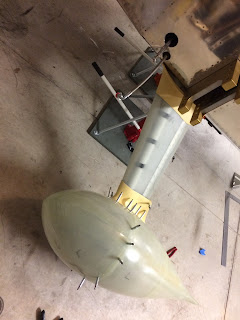Panel
It has been close to a year since I originally posted my plans for a panel, electrical system and component location. With 2018 around the corner I wanted to get the new year's designs out before the end of the holiday season. So without further adieu, I present the N10JW 2018 Panel! |
- Replaced my overly complicated Mag switch / start sequence with a tried and true ACS style key switch. While I liked the idea of holding two toggles up to start, it's a bit too complicated and not as easy as turning a key. Push button would also have been neat, but then there's still a mag sequence to start.. in the end ease of use won.
- Incorporated both the CO2 Test and warning light as well as a low voltage light and battery fault (EarthX Battery). My original idea was to see these errors on the PFD, but if there's a battery issue and it's not powering on then I can see the fault light.
- Removed Autopilot Power switch because I determined it's not needed. If I can't turn the servos off via the autopilot panel at the top, or withing the G3X or manually through the VPX then I can always just turn off the avionics (PFD stays on).
- My light control switches wouldn't fit in the middle section of the panel so I moved them down to the lower console. That allows me to move the dimmers to the middle panel area which in turn allows me to spread the radio stack out a bit.
- Added a 'Spare' to the left of the AC power and fan control. Right now I'm thinking I might wire this up to disconnect the Co-Pilot stick buttons. Default would be just to have it off unless someone is flying from the right seat.
- Added two traditional Circuit Breakers for the Air Conditioning. The AC pulls a lot of amps and no reason to route it through the VPX. Instead I'll use traditional push-pull CBs for the power.
- The only other real change involves the mapping of the control stick buttons. I wasn't sure what I wanted to use for button 5 on the Infinity sticks until I cam across this... which helped me make my decision.
Electrical Design
Periodically over the last year I would get into my Visio file and do updates to my previous baseline. Most the time it was the panel, but lately as I started to hone down on some decisions it's been to the other more important sections, ie component layout and power distribution.I finalized on going with a dual alternator and essentially a limited dual battery system. I call it limited because in case of battery, contactor or a VPX failure, my backup battery will only power up the PFD, engine and direction components and the GTN 650 GPS and comm system. Now if this all takes a dive then I have a G5 to help keep my wings level. All this really only matters if I'm in the clouds and can't see the sky or the ground. This set up should give me a few hours to get out of the weather and on the ground. The balance of simplicity with redundancy is something I focused on and am happy with my design.
I'm in what I would call the 'white gloves' phase of my design planning. The major stuff was in there just needed to QA it a bit more and be methodical about it. The first part was to get into my component drawing and remove or adjust anything that I know I don't plan on installing. The only major component I took out was the secondary ADAHRS (GSU 25). I learned the G5 can and will perform this function, sending info to the G3Xs if the primary ADAHRS goes down. This is a simple enough drawing that it's easy to change on the fly and adjust as needed.
 |
| Component Layout |
After I worked through the two above items I got to the meat of the work and that is updating the power distribution drawing.
Update - When I posted this originally a few days ago it was based on the assumption that each landing light would only need a 5.0A breaker. After talking with Jesse over at Saint Aviation he suggested I keep them at 10.0A each. I highly respect Jesse's knowledge and expertise on the subject of RV's so I had to do some modifications. That's really how fast these things can change, I fully expect this to continue to change until the plane is up and going.
 |
| RV-10 Electrical |
A lot is going on in the above drawing, but if you know a bit about what you're looking at it starts to make sense fairly quick. The idea is that if someone who didn't build the plane needs to know how things are connected they can view this schematic and get up to speed. As the builder, even though I haven't ran a single strand of wire yet, I have a path and plan to how from a power perspective things are connected. You're limited to 32 power pins off the VPX so most will supplement with a fuse block of some sort in order to provide power to non-critical flight items.


























































